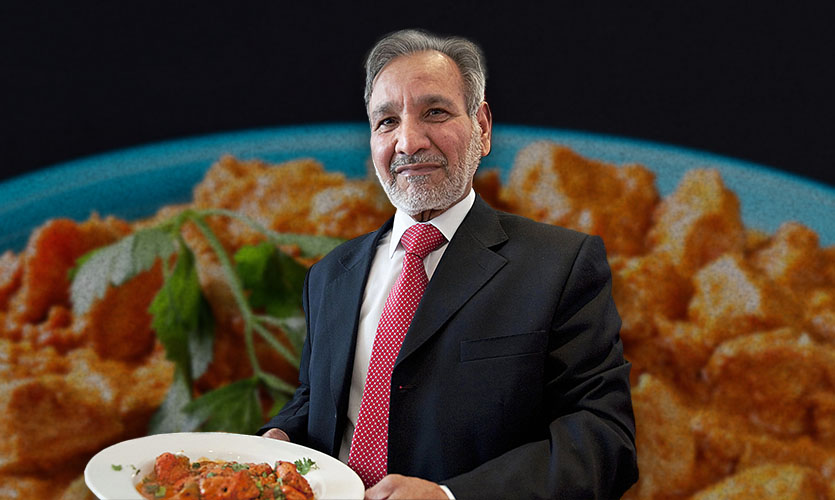Culinary artiste Ahmed Aslam Ali passed away on Wednesday, aged 77, leaving behind his recipe for one of the most appetising desi dishes – the Chicken Tikka Masala.
Ali’s passing compels one to bite into the piquant curry of Chicken Tikka Masala with a butter naan, and take a flavourful journey down the history of its origin all the way in Glasgow to its ascent to fame in Britain.
Yoghourt-marinated chicken chargrilled in the tandoor oven to get the smoky flavour, tossed in a rich & creamy sauce made with fresh onion and tomatoes, topped with butter and cream, is bound to make your mouth water. Be it the curry that bursts with flavour, or the culinary fable behind the birth of Chicken Tikka Masala, you will find each one in every non-vegetarian eating Indian or British household and restaurants.
Necessity: The Mother Of Invention!
Curry sprang to popularity during 1852, among the East India Company employees who returned to Britain and roughly translated for English cooks what they ate in India. This resulted in a curry dish that was milder, less spicy, less greasy, and had a more basic flavour. British cookbooks underlined how dinner is incomplete unless curries were a part of the meal. That indeed became a stepping stone for Chicken Tikka Masala.
The dish dates back to 1971, when on a rainy night in Glasgow, a crabbing bus driver ordered Chicken Tikka at Ahmed Aslam Ali’s Shish Mahal. Taking one look at the dish, the driver yelled discontentedly, “This is too dry! In Britain, meat needs gravy or some sort of sauce, or else what’s the point,” and sent it right back to the kitchen.
Hurriedly, Ali tossed in a can of Campbell’s tomato soup he was having for his ulcer. Thinking quickly on his feet, he added yoghourt, some spices, and gave the curry a stir. The driver wiped his plate clean and later brought his friends to taste the curry, who became regulars. Soon after, Chicken Tikka Masala made it on the menu. And the rest is history.
Even though it was a culinary invention to appease the British palate, Chicken Tikka Masala became a crowd favourite everywhere. Much like the recipe, the gravy is a palpable mix of different cultures. Akin to a skew of armies invading kingdoms and cultures and claiming lands, cookbooks from India, Pakistan and Bangladesh have waged a war on the claim over the invention of Chicken Tikka Masala.
Interestingly enough, Chicken Tikka, a dish of tandoor grilled chicken pieces, has its roots in the legendary kitchen of Moti Mahal in India, cooked by Kundan Lal Gujral. Gujral initially worked as a cook in a modest eatery in Peshawar, Pakistan, where he first stuck skewered pieces of boneless chicken doused in yoghourt into the tandoor, which was only used for breads like naan.
Something was definitely cooking up in his head, and it was bound to be delicious. When Gujral moved to Delhi and opened Moti Mahal in 1948, he invented the first restaurant version of the tandoor and a tandoori spice mix to go with it. Gujral’s reluctance to throw away the leftover chicken tikkas and the unavailability of appropriate refrigerators compelled him to come up with a way to preserve the tikkas. So, he poured tomato gravy with butter and cream onto the tikkas to soften it and then served it as ‘Murg Makhani’ the following day.
Et voila! Butter Chicken was introduced to the world. Chefs across the globe claim Butter Chicken to be the prototype and Chicken Tikka Masala as a modified version of it.
However, as desi as Chicken Tikka Masala sounds, it actually does not hail from Indian cuisine. While many believe that such recipes have been passed down during the reign of the British Raj or the kitchens of Mughal emperors, Chicken Tikka Masala was in fact founded by chef Ali, who was of Bangladeshi origin.
The Kohinoor Of Curries: Chicken Tikka Masala, From South Asia To Britain
Well over 75 percent of Indian restaurants in Britain were known to be run and owned by people of Bengali descent up until the early 1970s. Most came from East Pakistan, which then became Bangladesh in 1971. Many tandoori and Indian restaurants debuted in the East End of London’s Brick Lane, colloquially known as “Bangla Town”, which is still renowned for this brand of cuisine.
Presently, this curry has found its way into the plates of millions of Brits and South Asians, often devoured with naan and jeera rice. So much so that by 2009, Brits were consuming 2.5 billion pounds of Chicken Tikka Masala per year! It was no more just a culinary accident. It emerged as the symbol of a modern multicultural Britain.
In 2001, Robin Cook, the erstwhile-foreign secretary of the United Kingdom, praised Chicken Tikka Masala as a quintessential British invention. Known as a staple in most UK homes, the Chicken Tikka Masala is said to be Britain’s national dish.
Mohammad Sarwar, the Labour Party member of parliament for Glasgow Central, proposed the designation of the city as the origin of the Chicken Tikka Masala in 2009. He pushed in the House of Commons to have the curry granted EU Protected Designation of Origin status, but his quest remained unsuccessful.
This savoury curry provides food for thought, irrespective of its true origin. It is indeed a scrumptious amalgamation of British and South Asian cultures, histories and accidental inventions at the hands of various chefs! One such being Ahmed Aslam Ali, who has left behind Shish Mahal and the legacy of a rich cuisine.










